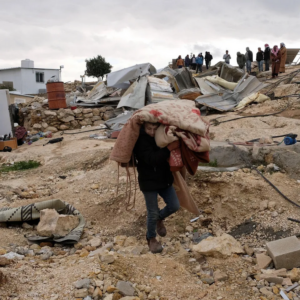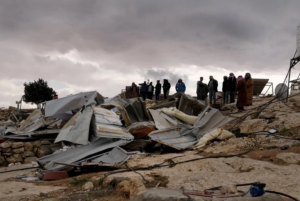The Palestinian father begged the Israeli troops to postpone demolition as so cold, to no avail

The aftermath of the civil administration’s demolition operation in Khallet al-Daba, February 2025
Gideon Levy writes in Haaretz on 14 February 2025:
The almond tree is blossoming now. Maybe that’s why they didn’t touch it. The cypresses are erect and evergreen, but no mercy was shown to them. One was uprooted and left like a corpse by the side of the road; the other was half torn out and now leans, shamed, against a shattered wall, waiting to die as well, slowly. Nor was mercy shown toward the washing machine – the god of the occupation does not pity washing machines – and it is sprawled, smashed, on the rocky ground. Why wreck the washing machine, too? Well, why not?
This week we visited the hamlet of Khallet al-Daba, “earth of the hyena,” in the demolition zone known as Masafer Yatta, a cluster of villages and hamlets in the South Hebron Hills, about an hour after the wrecking crew of the Israeli military government’s Civil Administration finished destroying the homes of seven of the site’s 18 families and rushed off to the next target, Jinba, on the other side of the hill.
About a dozen residents, robust, with weather-beaten faces, along with neighbors and relatives, young and old, were already clearing the opening of the cave that the Israeli wreckers had sealed with boulders – it was urgent to find a place out of the cold for the small children. The temperature was 9 degrees Celsius (48 Fahrenheit) in the early-afternoon sun. With a prodigious effort and the aid of a sledgehammer, the men of the hamlet smashed the boulders, then hauled off the rubble in black rubber baskets. All by hand. The cave’s interior became increasingly visible. It contained property and signs of the life that had been conducted inside. The locals insisted that we look inside and see what had been done to them, yet again.
It’s the sixth time that this site, touching in the way its residents maintain it, was demolished as part of the policy of expulsion and ethnic cleansing of the South Hebron Hills – and the sixth time those same residents have not even waited a second before beginning to rebuild. The scene here is particularly brutal because of the work that went into refining this cave home, the almost desperate effort to infuse it with a warm, agreeable domestic atmosphere. A wall mosaic made from desert pebbles, small solar-powered lights, paths of polished stone, potted herbs, synthetic grass and both fruit-bearing and decorative trees – all are intended to render this cave house as beautiful as can be in the impossible reality in which it was built.
The beauty is marred by the ruins. Two homes, lavatories and a kitchen were destroyed, and a large dwelling cave was sealed. The small cave was left untouched, for some reason. Civil Administration inspector Ilan, notorious here – a little God, or perhaps Satan – instructs the wreckers to demolish this and don’t touch that, and the workers do as ordered.
Jabbar Dababsi is the owner of a demolished home. We have been here twice already: in September 2019, after the house had been razed a second time; and in December 2020, following the third demolition. Two weeks after that event, Border Policemen pulled Dababsi out of a taxi and beat him, as revenge for trying to resist the destruction of his home. There were two more demolitions after that, and this week the sixth. This is an Israel Defense Forces “firing zone,” construction isn’t allowed here, unless you’re a violent Jewish settler.
Dababsi lives here with his wife, Osma, 31, and their five children; the youngest are 2-and-a-half year-old twins. His brother lives with his wife and their five children across the fence, and their home was also demolished this week. Jabbar was born here 36 years ago, and his father, who’s 86, was also born in this place. Solidly built, clad in black, Jabbar Dababsi is a study in ordeals. During the past few months, his home has also been attacked twice by settlers, who showed up once in uniform and once in civilian attire, supposedly to carry out a search.

The aftermath of the Civil Administration’s demolition operation in Khallet al-Daba, in the Masafer Yatta region, February 2025
“Imagine an open house and they break the windows to enter,” he says. Three months ago, Civil Administration personnel placed the latest demolition orders on the ground and secured them with rocks, before leaving. This past Monday, a little after 8 A.M., they returned.
Dababsi relates that he received a report about forces on the move near A-Rakeez, a village near the settlement of Avigayil, and in short order the armored column reached his hamlet. Together with two huge bulldozers and the excavator, an IDF Namer – an armored personnel carrier based on the Israeli Merkava tank – accompanied the troops.
Nasser Nawaj’ah, a field researcher for the Israeli human rights organization B’Tselem, who lives in nearby Palestinian Susya and has been documenting the demolitions here for some 20 years, says he’d never before seen a Namer in the service of the wreckers. “I thought they had come to do battle,” Nawaj’ah said, adding that he was sure that this time they had come to destroy the entire hamlet.
A boy pulls a half-smashed chair from the rubble. More and more people arrive to help or offer consolation.
When the convoy reached the entrance to the site, the soldiers ordered the residents to move a few dozen meters back. Then they began to remove objects and set about demolishing. Not everything was removed: The crew was in a big hurry, so the washing machine was destroyed. The refrigerator was spared. The inhabitants are now rescuing remains of property: a pencil, a notebook, a water filter apparatus, an internet router. The solar panels survived, the white water tanks were smashed.
Jabbar pleaded with them to postpone the demolition because of the cold and because he has toddler twins, but to no avail. The older children were at school, and when they got back they cried. Their father is already habituated to the experience – you won’t see him crying, not even complaining. His wife is sheltering in the small cave that wasn’t touched, with the twins, Mohammed and Thiam. In the dimness of the cave, they’re riding plastic bikes and look stunned.
In the adjacent compound, that of his brother Amar, 40, a home, two caves and two cisterns were demolished. In Jabbar’s compound, the rubble above a gas canister is being removed, as though a body were being rescued. The crushed iron gate lies askew. The brown ceramic tiles in Jabbar’s kitchen are shattered. A phone charger is rescued from the ruins. The broken security cameras, which were installed to deter and document the settlers’ violence, are waiting to be extracted from the wreckage.
The large dwelling cave is coming into view. When will you start to rebuild? “God will help,” Dababsi replies. So far, God hasn’t helped him.
The aftermath of the Civil Administration’s demolition operation in Khallet al-Daba, in the Masafer Yatta region, this week.Credit: Alex Levac
On Monday, the Israeli forces demolished the homes of 10 families – seven here, two in Jinba and one in Maghayir al Abeed – in one of the largest such operations in Masafer Yatta in recent years. The hills around Khallet al-Daba are dotted with the new settler outposts that have surfaced as part of a building spree during the war – in the northwest, the west and the east – along with expansions of the settlements of Mitzpeh Yair and Havat Maon.
On the hill across the way is another residential compound belonging to the community, and another act of destruction. This is the location of the home of Assud Dababsi, 62, father of seven. Last July 3, settlers set fire to his home, which was since repaired. This past Monday it was the homes of his brother and his son that were demolished, by the Civil Administration. The ruins are now strewn across the ground. Thirteen more souls made homeless.
“Free Khallet al-Daba,” someone has written in English on the wall of the shed that served as a community center for the local residents, with the aid of European countries and Canada. The shed is still standing.
A spokesperson for the Coordinator of Government Activities in the Territories this week stated in reply to a query from Haaretz: “The inspection unit of the Civil Administration carried out administrative enforcement activity against a number of construction elements that were built in violation of the law. The activity was carried out lawfully and was approved by the political echelon.” Translation: “Construction elements” are people’s homes; “political echelon” is Bezalel Smotrich, the minister in charge of the ethnic cleansing that Israel is perpetrating, and not only in the Gaza Strip.
Scenes of devastation like those in Khallet al-Daba are at the heart of the jolting, painful documentary film “No Other Land,” which is on the short list for an Oscar in the Best Documentary Feature category. The filmmakers are already preparing to fly to Los Angeles to attend the ceremony on March 2. If anyone thought that the international response already elicited by the film, and the many awards it has already reaped, will stop the evil being perpetrated by the Israeli apartheid administration, they were wrong. That administration doesn’t even dream of touching the wild, violent settler outposts that have cropped up here and are suffocating Khallet al-Daba from every direction.
With all due respect to the Academy Awards, nothing will stop the process of ethnic cleansing. Will many Israelis view the film? Would they be able to bear the anguish and feelings of guilt that it must stir in them? Would they feel respect not only for its makers – Basel Adra, Yuval Avraham, Hamdan Ballal and Rachel Szor – but mainly for the people of Masafer Yatta, who are waging a struggle as lengthy, determined and consistent as it is nonviolent, impressive and inspiring for their lands and their lives?
Here’s what one of the two protagonists in the film, Basel Adra, who is one of its co-directors and also a B’Tselem field researcher, wrote this week on X: “Masafer Yatta is disappearing in front of my eyes. Only one name for these actions: ethnic cleansing.”
This article is reproduced in its entirety
